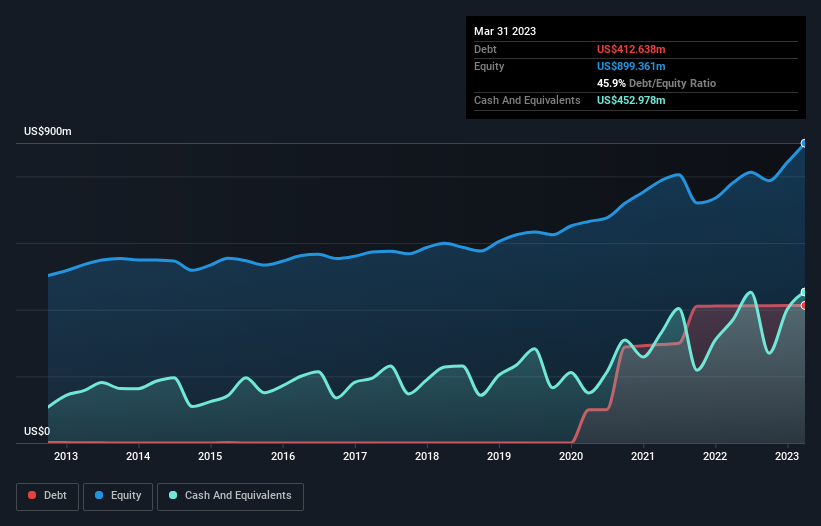- United States
- /
- Consumer Services
- /
- NYSE:LRN
These 4 Measures Indicate That Stride (NYSE:LRN) Is Using Debt Safely

Howard Marks put it nicely when he said that, rather than worrying about share price volatility, 'The possibility of permanent loss is the risk I worry about... and every practical investor I know worries about.' So it seems the smart money knows that debt - which is usually involved in bankruptcies - is a very important factor, when you assess how risky a company is. Importantly, Stride, Inc. (NYSE:LRN) does carry debt. But the more important question is: how much risk is that debt creating?
When Is Debt A Problem?
Generally speaking, debt only becomes a real problem when a company can't easily pay it off, either by raising capital or with its own cash flow. If things get really bad, the lenders can take control of the business. However, a more frequent (but still costly) occurrence is where a company must issue shares at bargain-basement prices, permanently diluting shareholders, just to shore up its balance sheet. Of course, debt can be an important tool in businesses, particularly capital heavy businesses. The first thing to do when considering how much debt a business uses is to look at its cash and debt together.
See our latest analysis for Stride
What Is Stride's Debt?
As you can see below, Stride had US$412.6m of debt, at March 2023, which is about the same as the year before. You can click the chart for greater detail. However, it does have US$453.0m in cash offsetting this, leading to net cash of US$40.3m.

How Strong Is Stride's Balance Sheet?
The latest balance sheet data shows that Stride had liabilities of US$284.2m due within a year, and liabilities of US$516.2m falling due after that. Offsetting this, it had US$453.0m in cash and US$474.7m in receivables that were due within 12 months. So it actually has US$127.2m more liquid assets than total liabilities.
This short term liquidity is a sign that Stride could probably pay off its debt with ease, as its balance sheet is far from stretched. Succinctly put, Stride boasts net cash, so it's fair to say it does not have a heavy debt load!
Another good sign is that Stride has been able to increase its EBIT by 20% in twelve months, making it easier to pay down debt. There's no doubt that we learn most about debt from the balance sheet. But it is future earnings, more than anything, that will determine Stride's ability to maintain a healthy balance sheet going forward. So if you want to see what the professionals think, you might find this free report on analyst profit forecasts to be interesting.
Finally, while the tax-man may adore accounting profits, lenders only accept cold hard cash. While Stride has net cash on its balance sheet, it's still worth taking a look at its ability to convert earnings before interest and tax (EBIT) to free cash flow, to help us understand how quickly it is building (or eroding) that cash balance. Over the last three years, Stride recorded free cash flow worth a fulsome 88% of its EBIT, which is stronger than we'd usually expect. That puts it in a very strong position to pay down debt.
Summing Up
While we empathize with investors who find debt concerning, you should keep in mind that Stride has net cash of US$40.3m, as well as more liquid assets than liabilities. And it impressed us with free cash flow of US$162m, being 88% of its EBIT. So is Stride's debt a risk? It doesn't seem so to us. Over time, share prices tend to follow earnings per share, so if you're interested in Stride, you may well want to click here to check an interactive graph of its earnings per share history.
When all is said and done, sometimes its easier to focus on companies that don't even need debt. Readers can access a list of growth stocks with zero net debt 100% free, right now.
New: Manage All Your Stock Portfolios in One Place
We've created the ultimate portfolio companion for stock investors, and it's free.
• Connect an unlimited number of Portfolios and see your total in one currency
• Be alerted to new Warning Signs or Risks via email or mobile
• Track the Fair Value of your stocks
Have feedback on this article? Concerned about the content? Get in touch with us directly. Alternatively, email editorial-team (at) simplywallst.com.
This article by Simply Wall St is general in nature. We provide commentary based on historical data and analyst forecasts only using an unbiased methodology and our articles are not intended to be financial advice. It does not constitute a recommendation to buy or sell any stock, and does not take account of your objectives, or your financial situation. We aim to bring you long-term focused analysis driven by fundamental data. Note that our analysis may not factor in the latest price-sensitive company announcements or qualitative material. Simply Wall St has no position in any stocks mentioned.
About NYSE:LRN
Stride
A technology-based education service company, engages in the provision of proprietary and third-party online curriculum, software systems, and educational services in the United States and internationally.
Undervalued with solid track record.


